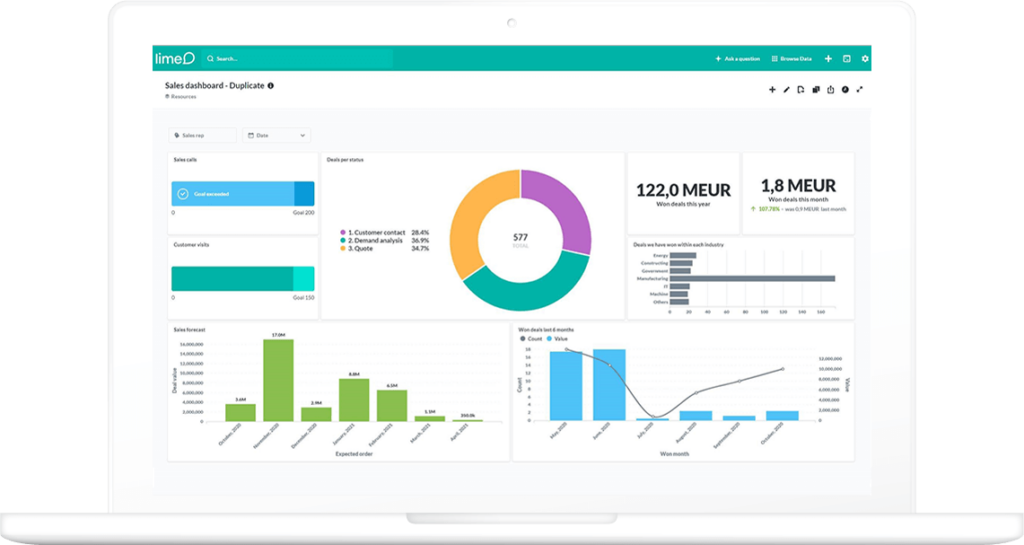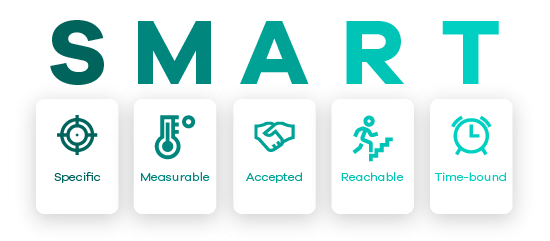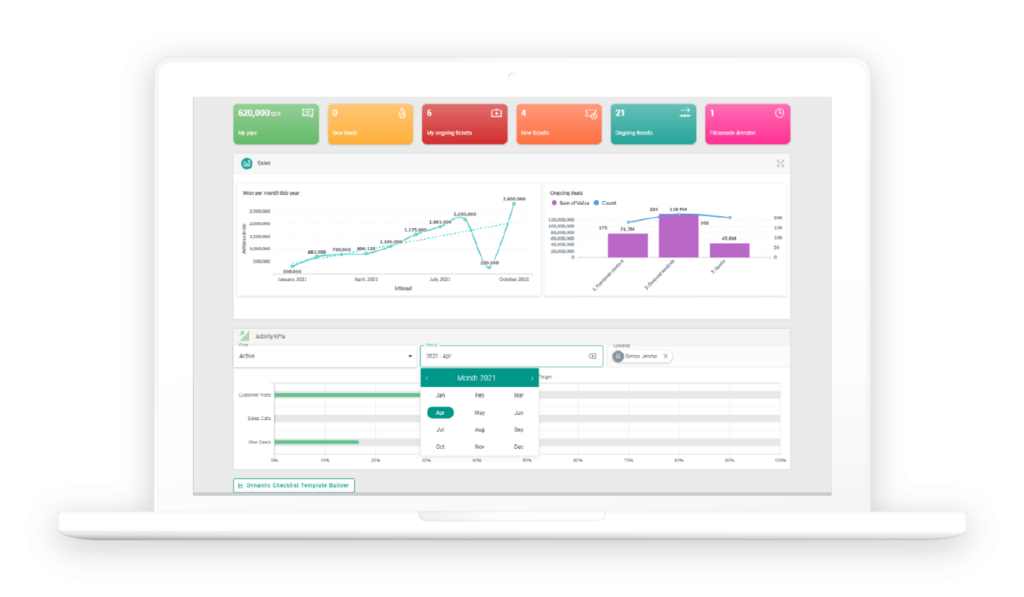
Which KPIs are most important for your sales?
How can your sales team improve their results? The obvious answer is of course to set goals and make sure everyone works towards them. The trick is to monitor developments over time. With the help of a number of KPIs, it’s quick and easy to see if you’re on the way to reaching your sales goals.
A salesperson’s job has become more than sales. It’s about understanding the customer’s buying behaviour and creating a positive buying experience that’s on the customer’s terms. Are you on the right track? Your KPIs should answer that question.
What does KPI mean?
The acronym KPI stands for Key Performance Indicator. In other words, it’s certain key figures that help you measure your performance. KPIs are traditionally used to measure companies economic development. In sales and marketing, KPIs are used to evaluate the results of certain activities within a certain period of time.
Results that are visible over time
Well-chosen KPIs give your sales department a visual development curve that clearly answers the question of whether they’ll achieve their goals or not. So it’s important to have different KPIs that show development every month, week and, in some cases, every day.
Your sales process will affect which KPIs create value for you. At the same time, well-defined KPIs provide a direction for the organisation as a whole. The goal of KPIs is to be able to follow up work over time in order to:
- Be able to establish a forecast that follows a set budget or other fixed goals.
By producing key figures for each month, week and working day, you ensure that your sales team delivers in line with the set budget. This allows you to quickly adjust your sales strategy, maximise your potential, and reach your sales goals. - Evaluate the results of the business to see if your prioritised activities deliver the expected results.
With a selection of the right KPIs, it’s easy for the sales team to prioritise the activities that create results. Do you tend to reach your monthly goals? By following up key figures over time, you gain a better understanding of what your challenges are. In the same way, you can quickly see if any KPI needs to be adjusted up or down. - Follow up individuals and teams’ performance over time.
Most salespeople are used to individual sales goals. With clear KPIs and regular follow-up, it’s quick and easy for you as a salesperson to see when you perform in line with your goals and when you don’t. Sales managers can better support their employees when they know which key figures each team member delivers on. With that information, you can provide concrete support and create initiatives that have a real impact on the result.
Choose KPIs that benefit the entire organisation
In order for your KPIs to be sustainable, it’s important that they’re anchored in the organisation as a whole. You must all move towards the same goal, even if the path to get there looks different for everyone.
There are special benefits to syncing certain KPIs between the sales and marketing departments. This is because the website and other marketing tools are often important channels for incoming leads that the sales department will then process.

In the same way, it’s important to anchor selected KPIs to top management.
The advantage of this is:
- Greater opportunities for the rest of the organisation to contribute to better results by working with incoming leads from marketing, increased customer satisfaction and loyalty via support and customer service, feedback on sales of various products and services that may be of value to product development and other strategic decisions.
- Better understanding of current challenges and successes in the sales department.
- Clear arguments for, for example, recruiting more salespeople or changing commission models for better results.
8 examples of KPIs that work in B2B
How do we choose the right KPIs? The question is as common as it is complex. The overall goals of the business, your sales team and your sales strategy affect which KPIs and key figures are important to your sales.
Working with KPIs at the departmental and organisational levels is important for long-term results. But, of course, success requires that each individual is able to deliver. To measure the performance of individual salespeople, it’s wise to measure, for example, the number of booked meetings, the number of quotes sent and the number of closed deals.
That said, there are a number of other recurring key figures that lot of sales departments use to measure their success. Here are some examples of KPIs that are common in B2B sales:
- Number of new incoming leads or organisation numbers
When working with sales in B2B, unique organisation numbers are important. This is because it’s often easier to sell something to a company when you already have a way in. So it’s particularly important to continuously add new organisation numbers to your pipeline. - Number of qualified leads (SQLs – sales qualified leads)
Leads can come o you in a number of ways, but it’s only when they’re qualified that salespeople can take over and process them. So the number of SQLs – sales qualified leads – is a good KPI to ensure an influx of potential customers. - Hit rate of leads or prospects who become customers
How many of your prospects become customers? Count the number of deals won and divide it by how many people you’ve been in contact with, and you’ll get your hit rate. With the help of this key figure, you can calculate how many contacts or leads you need in order to reach your sales goals. - Average time from first contact to completed transaction
In B2B sales, it’s not uncommon for a deal to take several months to close. Especially when the customer didn’t know your company beforehand and you have to start by making a cold call. By measuring the time from first contact to completed transaction, you’ll learn how to support the customer in the right way so they can make quicker decisions. - Average value per transaction
How much of a difference will it make if you raise the average value per transaction by X%? Picking the low-hanging fruit is always smart, but remember to evaluate which transactions have the highest average value. - Average cost for each new customer
What does each new customer cost you? Here, you should include the salesperson’s salary and time, but also the cost of marketing, scheduling meetings and holding relationship-building events. No customer is free, but with the right information, it’s easier to know which activities truly create value - The customer’s value over time, often called customer lifetime value
How many services or products does your average customer purchase? How long do your customers stay with you? These are relevant questions when it comes to calculating customer lifetime value (CLV). - Sales growth, i.e. the increase in sales from one time period to another
Calculate your results from one month to another to discover your organic sales growth. If sales are particularly unstable across the year, you can also compare total accumulated growth with the same period last year.
A KPI can measure both activity, results and efficiency in the sales organisation. At the same time, it’s important to remember that no salesperson is an island – goal achievement also depends on how the rest of the organisation performs.Work SMART with KPIs
Work SMART with KPIs
In order to successfully reach certain KPIs, it’s important that the key figures are clearly defined. The easiest way to do this is to follow the SMART objectives method. The advantage of this technique is that you can clearly see how your results are going..

Each KPI should be:
- S – Specific
- M – Measurable
- A – Acceptable
- R – Realistic
- T – Time-bound
All sales departments want, for example, “to increase sales”. That’s fine, but it’s not a specific goal. What needs to happen for you to consider your sales increased? If we apply the SMART method to that goal, we get something more like:
“Within three months, the sales department will have increased its revenue by 14%.”
Straight away, we’re time-bound (three months), specific (increased its revenue) and measurable (14 ).
In addition to this, the goal has to be realistic, which of course depends on how things look today and how fast you normally increase your sales goals.
Finally, the key figure must also be acceptable. In this case, it should mean that you must come to an agreement with the team if there happens to be any uncertainty about whether the goal’s reasonable or not. Acceptance can also come from management: Is this a key figure for the business as a whole, in line with the organisation’s other goals?
Goodbye Excel, say hello to your new KPI dashboard!
It pays to work in a goal-oriented way. With the right tools, it’s easy. You don’t have to continuously update an Excel file in order to follow your development. Instead, you can easily define KPIs at the team and individual levels right in your CRM.
With Lime CRM you can define and follow up on goals for the entire organisation, an entire team, individual salespeople, and even individual customers. You’re the boss, and can define the goal, time period and who it applies to. You can then follow the development curve on your KPI dashboard and see the sales team’s performance over time.
This, in combination with company information and customer history gives your sales team all the information they need to make data-driven decisions that yield results. Setting up and evaluating salespeople’s goal achievement has never been simpler.

Do you want more sales?
There’s no time to waste! Let’s find the solution that will help you get more customers and turn existing ones into loyal ambassadors today.